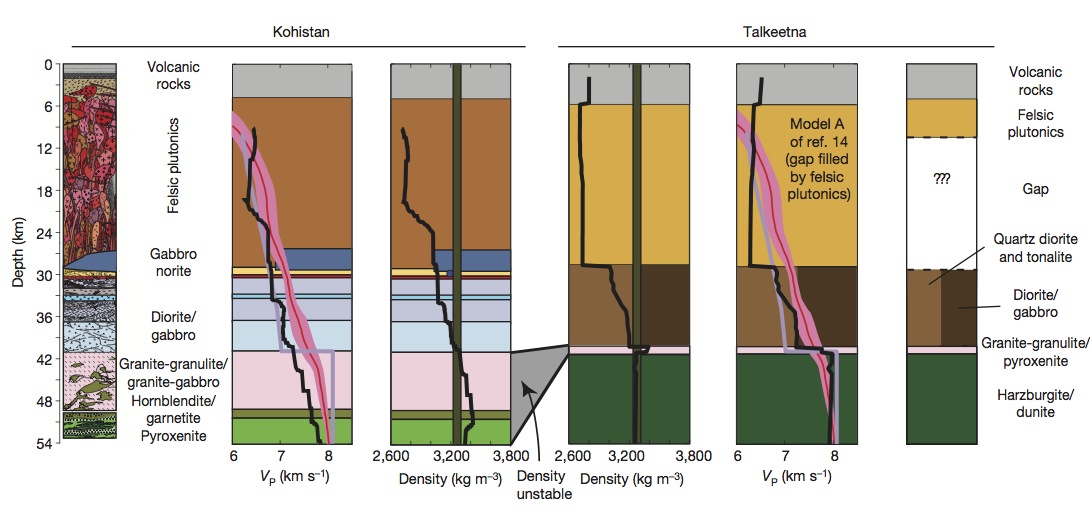
How a Mysterious 'Moho' Forms Beneath Earth's Crust

A dense crystalline "rain" falling into Earth's mantle could explain how a mysterious seismic boundary forms beneath the crust, according to a study published today (Dec. 4) in the journal Nature.
The model, based on rock evidence from volcanic islands that smashed into Asia and Alaska, confirms long-standing ideas about how continents are born.
"There are a lot of things I think this study will resolve and a lot of questions that will remain," said lead author and MIT geologist Oliver Jagoutz.
The seismic boundary investigated by Jagoutz and co-author Mark Behn, of the Woods Hole Oceanographic Institution in Woods Hole, Mass., is called the Moho, after Croatian seismologist Andrija Mohorovicic. In 1909, Mohorovicic realized earthquake waves suddenly sped up at a sharply defined boundary that hovers about 25 miles (40 kilometers) beneath continents. The discovery revealed Earth was divided, with a lighter crust and denser mantle where the seismic waves traveled faster.
Because the Moho is so deep, no one has ever seen it directly, but scientists have spent entire careers explaining why it exists and how it forms.
Misplaced Moho
One enduring puzzle has been the missing Moho — the boundary's absence beneath volcanic island chains, such as Japan's Izu-Bonin islands, that rise above colliding tectonic plates. Because these "island arcs" are the building blocks of continents, the missing Moho is a mystery. For example, the East Coast of North America has a clear, crisp Moho, but it is also quilted from scores of volcanic chains slamming into the continent's edge several hundred million years ago. Another problem is the rocks in continents are about 10 percent richer in silica than oceanic crust, which is the source of magma that feeds volcanic island chains. [Infographic: Tallest Mountain to Deepest Ocean Trench]
Get the world’s most fascinating discoveries delivered straight to your inbox.
"If we want to produce continental crust in arcs, we are left with two problems," Jagoutz told LiveScience's OurAmazingPlanet. "The rocks we find on the surface of continents all resemble lavas that are erupted in subduction zones, but there needs to be a mechanism that brings the melt from 50 to 60 percent [richer in silica]," he said. "Another problem we have is the structural problem. Somehow we need to introduce this major structural discontinuity, the Moho, that we don't have in arcs but we have in continents."
To solve the Moho mystery, Jagoutz and Behn found a way to look at the lower crust via fragments of former volcanic island chains now shoved up to the surface in mountain belts in Pakistan and Alaska. These rocks were once 25 to 31 miles (40 to 50 km) deep. They created a geophysical model of the crust based on the rocks, and compared it to seismic data from today's island arcs.
Planetary windows
The Pakistan rocks resemble modern island arc settings. There's no sharp density contrast that would produce a Moho boundary. The layers reveal a thick, continuous section of rocks of similar density, such as gabbros, at the depth of the Moho. But in Alaska, these rocks are missing. Instead, at the depth where the Moho would sit, there's a sharp density increase in the rock layers, with rocks called harzburgites and dunites instead of gabbros.
Jagoutz thinks the missing dense rocks provide the clue to what happens at volcanic arcs.
Inside the Earth, in the lower crust, a "rain" of dense crystalline material (called cumulates) falls from the base of the crust. The rocks are denser than the underlying mantle and sink down into the Earth. This process, known as delamination or foundering, continually peels off pieces of the lower crust.
"It's like icebergs, but the stuff that's actually dropping off is actually underwater," Jagoutz said.
Removing these dense rock leaves lighter, silica-rich materials behind — like the rocks found in continents, Jagoutz said. [Granite: Bedrock of the Earth]
Sinking down
The researchers think the Moho starts to appear with big changes in volcanism, such as when melting stops or subduction shuts off. Because volcanic island chains appear above subduction zones, where a tectonic plate sinks into the mantle and releases fluids that trigger melting, new magma will rise upwards and replace the missing crust. But without new magma replenishing the crystalline rain, eventually a sharp boundary will appear between lighter material in the crust and the dense mantle below.
"When this happens, the mantle will remain relatively hot for a while and the material will continue to sink back down," Jagoutz said.
Geologist Suzanne Kay of Cornell University, one of the original proponents of crustal delamination in island arcs, said the study was "an interesting paper" but doesn't cover significant new ground.
"The idea of delamination in oceanic and continental arcs and the link with the composition of the continental crust by delamination have been around for more than 20 years, and others are also thinking of the ultimate fate of the delaminated material," Kay said in an email interview.
Email Becky Oskin or follow her @beckyoskin. Follow us @OAPlanet, Facebook & Google+. Original article on LiveScience's OurAmazingPlanet.

